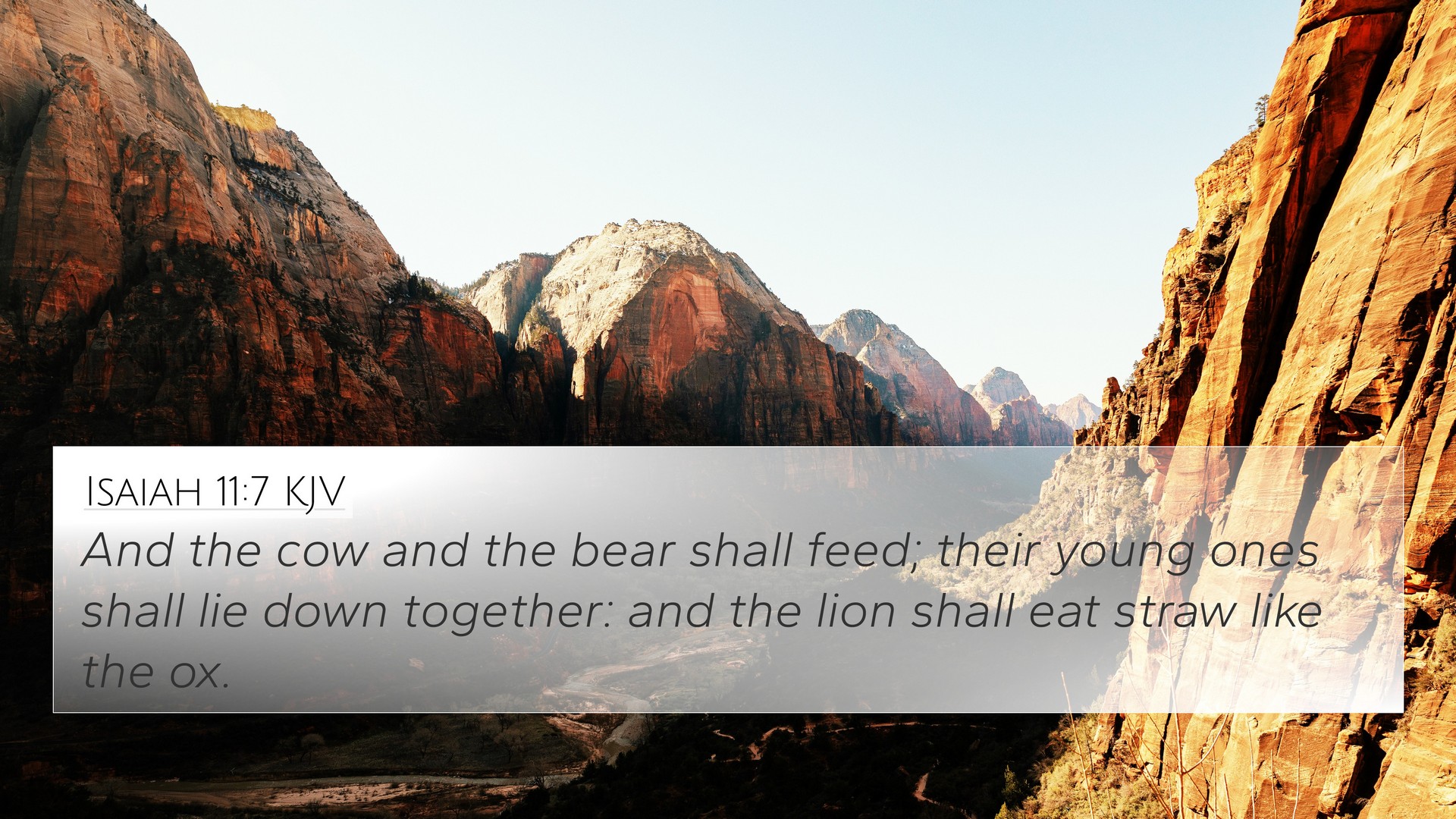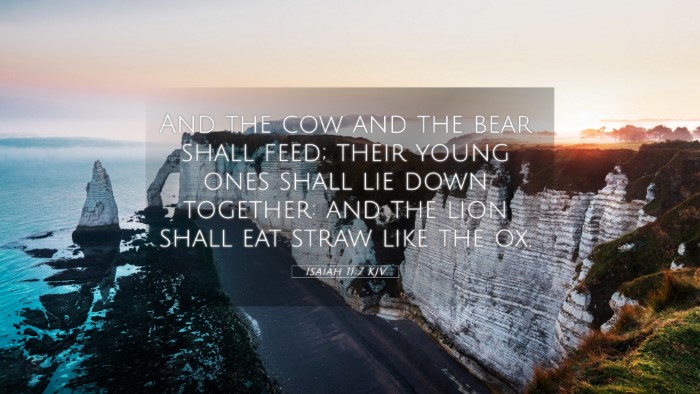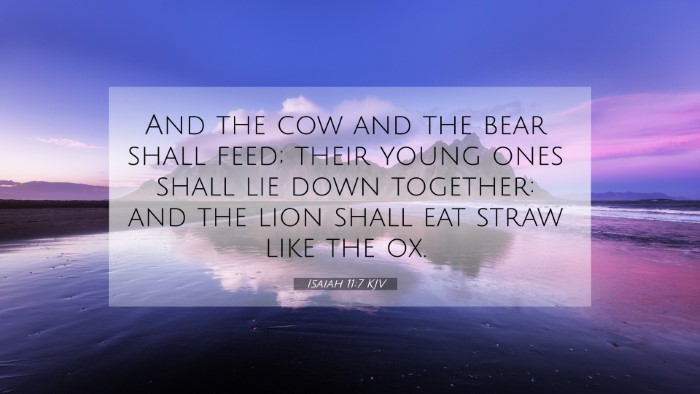Isaiah 11:7: "And the cow and the bear shall feed; their young ones shall lie down together: and the lion shall eat straw like the ox."
This verse presents a prophetic vision of peace and harmony in the kingdom of the Messiah, which will transform the natural order. Following is a detailed exploration and interpretation based on several public domain commentaries.
Summary of Isaiah 11:7 Meaning
The imagery in Isaiah 11:7 vividly illustrates a future state of peace in which natural enemies coexist harmoniously. Here are some key insights:
- Matthew Henry:
Henry highlights that the verse exemplifies a time when even the fiercest creatures, typically at odds with one another, will find peace. He emphasizes that this denotes a transformative reign of the Messiah, bringing about universal peace not just among humans but across all creation.
- Albert Barnes:
Barnes interprets this verse as a representation of the ideal society that the Messiah will establish. The lion, a symbol of power and ferocity, will eat straw—the diet of a herbivore—indicating that a significant change in man's moral and spiritual state would occur.
- Adam Clarke:
Clarke focuses on the symbolic nature of the animals mentioned. He draws attention to the cow and bear, animals known for their contrasting natures, being capable of cohabiting peacefully. This emphasizes the radical peace that Jesus Christ will bring as part of the new covenant.
Connections Between Bible Verses
The underlying theme of peace and restoration in Isaiah 11:7 connects with numerous other biblical passages:
Related Bible Cross-References:
- Isaiah 65:25: "The wolf and the lamb shall feed together, and the lion shall eat straw like the bullock: and dust shall be the serpent's meat. They shall not hurt nor destroy in all my holy mountain, saith the LORD." This verse parallels in expressing the envisioned harmony in the new creation.
- Romans 8:21: "Because the creature itself also shall be delivered from the bondage of corruption into the glorious liberty of the children of God." It signifies the redemption of all creation, resonating with the themes from Isaiah.
- Micah 4:4: "But they shall sit every man under his vine and under his fig tree; and none shall make them afraid: for the mouth of the LORD of hosts hath spoken it." This verse similarly depicts a time of peace and safety.
- Revelation 21:4: "And God shall wipe away all tears from their eyes; and there shall be no more death, neither sorrow, nor crying, neither shall there be any more pain: for the former things are passed away." Prophetic peace and restoration in the New Jerusalem align closely with the prophecy in Isaiah.
- Matthew 5:5: "Blessed are the meek: for they shall inherit the earth." This connection emphasizes the theme of humility leading to peace.
- Psalm 104:14-15: "He causeth the grass to grow for the cattle, and herb for the service of man: that he may bring forth food out of the earth." This illustrates God's provision to all living beings, which will be seen in fullness in the Messiah's kingdom.
- Zechariah 9:10: "And I will cut off the chariot from Ephraim, and the horse from Jerusalem, and the battle bow shall be cut off: and he shall speak peace unto the heathen: and his dominion shall be from sea even to sea, and from the river even to the ends of the earth." This reinforces the messianic peace theme present in Isaiah 11:7.
Thematic Bible Verse Connections
The message of Isaiah 11:7 is significant in understanding the overarching themes of transformation and redemption in the scriptures:
- Peace and Reconciliation: Isaiah conveys a future hope where enmity turns into harmony.
- Creation’s Restoration: The natural order returning to its intended peace reflects the broader biblical narrative of redemption.
- Messianic Age: The prophetic nature of this verse points towards the arrival of Christ who ushers in peace.
Tools for Bible Cross-Referencing
Understanding cross-references like those illustrated helps deepen insight into scriptures. Here are some tools and methods:
- Bible Concordance: Great for finding words and themes across scriptures.
- Bible Cross-Reference Guide: Helpful in locating specific connections between verses.
- Cross-Reference Bible Study: Techniques designed to explore interrelated scriptures deeply.
How to Use Bible Cross-References
Using Bible cross-references involves finding and studying related verses, which enhances comprehension:
- Identify Themes: Focus on particular themes or subjects that interest you.
- Study Context: Look at the scripture surrounding the verse for better understanding.
- Related Verses: Use your findings to identify similar sentiments or teachings across the Bible.
Example of Inter-Biblical Dialogue
Engaging in inter-Biblical dialogue means considering how various scriptures illuminate and inform each other. For instance:
- Comparing Old Testament prophecies about peace with New Testament fulfillment provides insights into God's plan.
- Seeing how Jesus fulfills Old Testament promises sheds light on His role as the Prince of Peace.
Conclusion
Isaiah 11:7 serves as a powerful reminder of the peaceable kingdom that God has promised through the Messiah. By utilizing tools of cross-referencing and recognizing thematic connections, one can gain a deeper understanding of scripture and how various verses relate to one another elegantly.


